WCET and the Online Learning Consortium (OLC), in conjunction with the National Center on Disability and Access to Education (NCDAE is a partner with WebAIM), jointly offer this blog post on a topic of national interest to education communities. This post is part of the on-going collaboration on accessibility issues between WCET and OLC.
Join us for our upcoming Halloween webcast: Web Accessibility: Trick or Treat, where our panel of “been there, done that” experts will share their tricks, tips, and strategies for making accessibility a treat, and a little less scary.
Enjoy the read and enjoy your day,
Lindsey Downs, WCET
Many of us have heard of the Law of Holes; “If you find yourself in a hole, stop digging”. The deeper the hole, the harder it is to get out.
For institutions working to create a culture of digital equity or legal protection, institutional accessibility can start as a hole from which you must climb out. One of the many shovels that work to deepen the accessibility hole is the procurement of goods or services that are not themselves accessible. However, accessible procurement can offer a ladder, helping you get out of that hole more quickly.
In today’s blog post, I outline five actionable steps that should help you stop digging deeper, and help you get out of an accessibility hole, in part, through accessible procurements.
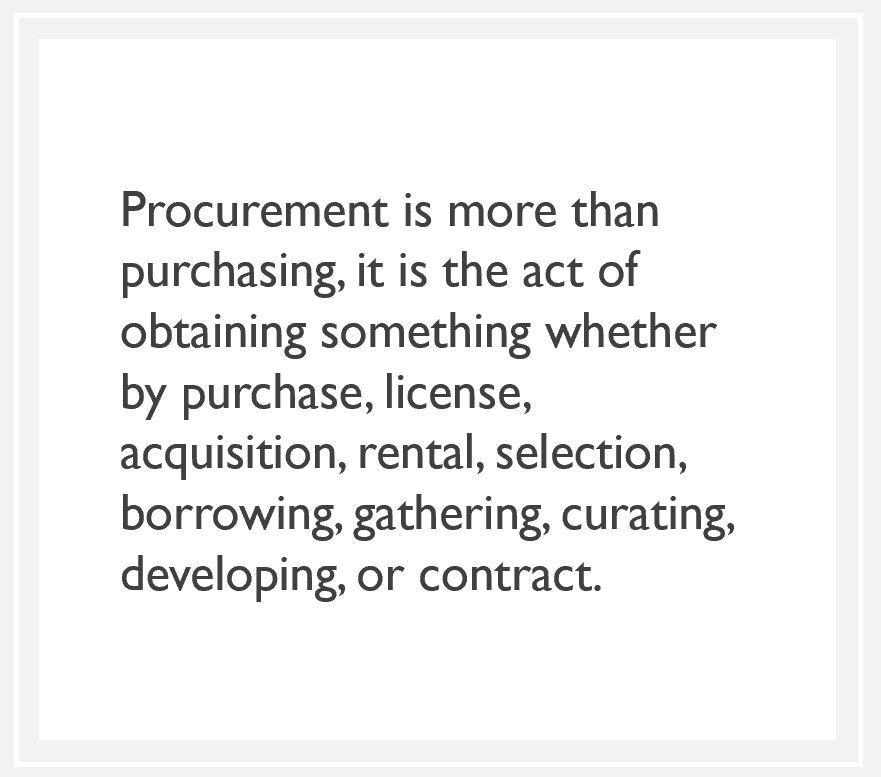
Step 1: Understanding the Criticality of Accessible Procurements
Every institution “procures” goods and services for their digital environments. Examples include the licensing of an institutional LMS or financial system, contracting with outside developers to create an online registration system or web templates for departments to use, the decision to use Google Docs in an academic program, or even the selection of open educational resources or digital journals by faculty in coursework. Whether this is done by central administration, by purchasing staff, or by individual faculty, the institution is responsible for the ultimate accessibility of that which is procured and used.
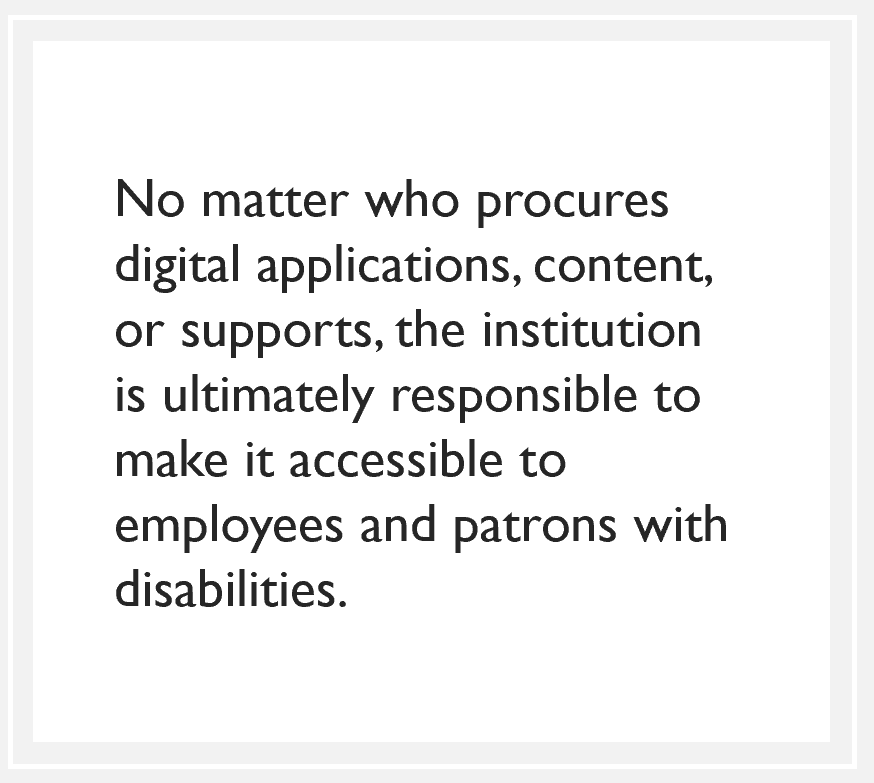
This responsibility hearkens back to the requirements put in place by the Americans with Disabilities Act in 1990. Institutions were responsible for physical access of the built environment (e.g., ramps, elevators, and disability bathroom stalls to name but a few). This responsibility resulted because the institutions themselves were in charge of the bid requirements, and in selecting architects and contractors. As such they were viewed as having control over the finished product, or at least being able to fix the finished product. Moreover, renting or leasing spaces from others did not remove the obligation to provide access to the built environment; the “it’s not ours so we should not have to fix it” defense was ineffective in the courts.
As we fast-forward into the digital world, many of the same arguments apply. While we know that an institution can choose to procure things that are not accessible, they are on the hook to make them accessible if students, faculty, staff, or community members with disabilities need access. This need occurs with stunning frequency and is often the genesis of complaints and litigation. One smart move by an institution is to shift the responsibility of making these systems accessible back to those who developed them rather than accept that responsibility, cost, and liability. This is an important mindset shift: To procure items that are accessible from the beginning, so that YOUR resources are not tapped as you work toward accessibility conformance.
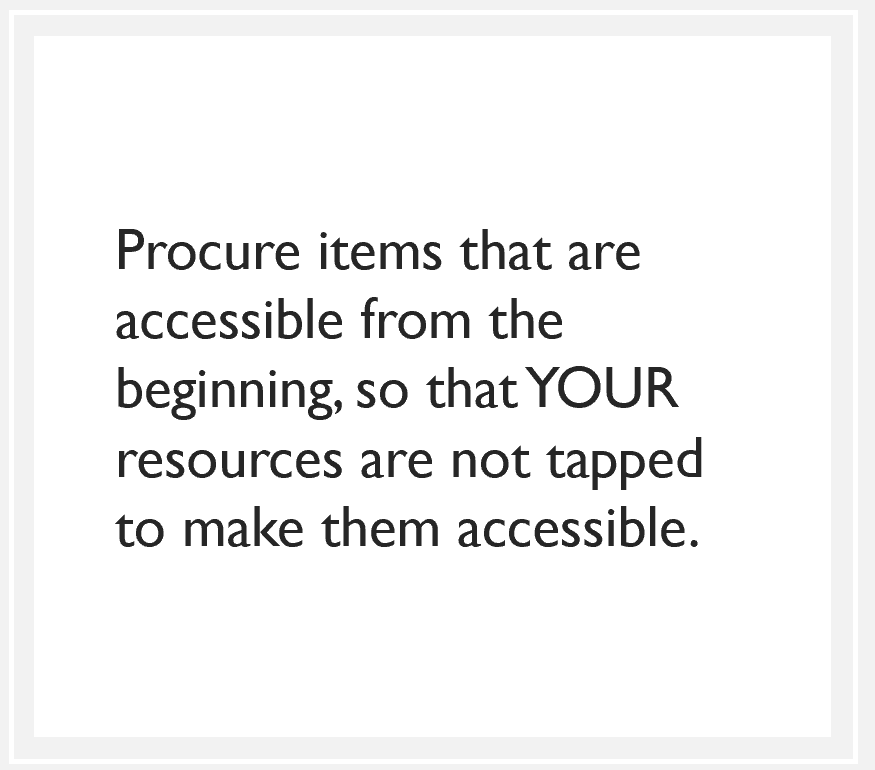
This procurement logic has common footing with security issues in higher education. More institutions now include security features as a precursor to procurement of many technology systems. Accessibility requirements during a procurement process would function in the same fashion.
Procurement is often confused with purchasing. Yet it is much broader than a purchase. In fact, while many campuses have procedures in place for purchasing, often there is a dollar threshold (e.g., $5,000) that will spring into effect the use of institutional purchasing policies. While this will catch larger purchases, some items that can have broad impact may go undetected or unexamined because they are either free or do not meet the dollar threshold that puts them through official purchasing processes. Think of the impact of freely available products on campus (e.g., WordPress, Google Calendar, Google Docs, or YouTube) when used by an institution.
So, procurement is simply the act of obtaining something (i.e., purchase, license, acquire, rent, select, borrow, gather, curate, develop, or contract). Remembering this will help you recognize where you may be vulnerable, and where you may need to act. This reflection is an important first step.
Step 2: Include accessibility in procurement
Many institutions currently have, or are creating, an institutional policy to cover the accessibility of electronic and information technologies (E&IT). Yet many did not include procurement specifically in that policy. Doing so can have positive effects. For example, in 1998, Congress amended the Rehabilitation Act to include a requirement that the Federal Government would make all their own E&IT accessible to citizens with disabilities.
One brilliant aspect of this law is that it was tied to Federal procurement policies. Section 508 is that aspect of the law which requires Federal Agencies to develop, procure, maintain, and use accessible E&IT. The law never said that vendors or makers of E&IT needed to make their products accessible. On the contrary, it only required that Federal Agencies restrict their procurements to those things that meet their accessibility criteria, with provisions for procurements of the “most accessible” when no such product line fully conforms to the standard. The purchasing power of the federal government created market-driven changes which are still in effect today.
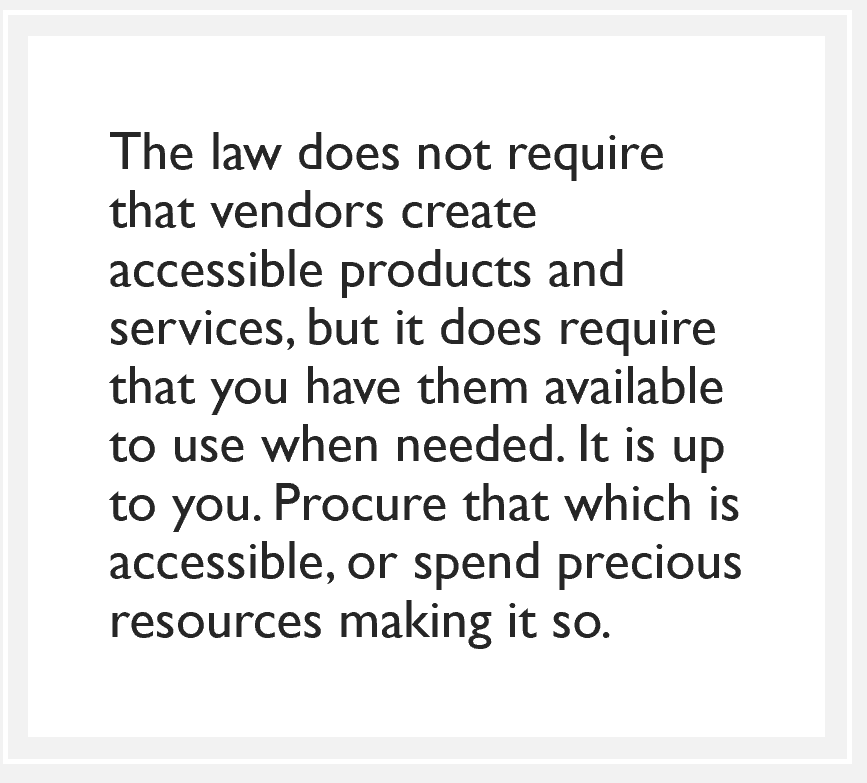
This is a model that many in higher education have decided to embrace and emulate. While establishing institutional policy on accessibility is important, assuring that this policy flows to procurement is smart. What a policy can do is set the occasion for institutional expectations, for budgets, and for processes that will reinforce the end goal of accessibility.
Examples of institutional standards or policy that include accessible procurement:
Step 3: Place accessibility into every RFP/RFA, and contract for E&IT
When an institution has a policy, they develop procedures to support that policy. For accessible procurements to take place, you would likewise want procedures to follow.
For those procurements that result in a purchase, an internal or external work for hire, or a license, an institution will often begin by creating a Request for Proposal (RFP), or Request for Application (RFA). As these go out, they set the expectations for each vendor or contractor who will respond. Because of this, it is critical that accessibility becomes a required feature of the procurement. Here are four things that you may want to include as part of this announcement phase:
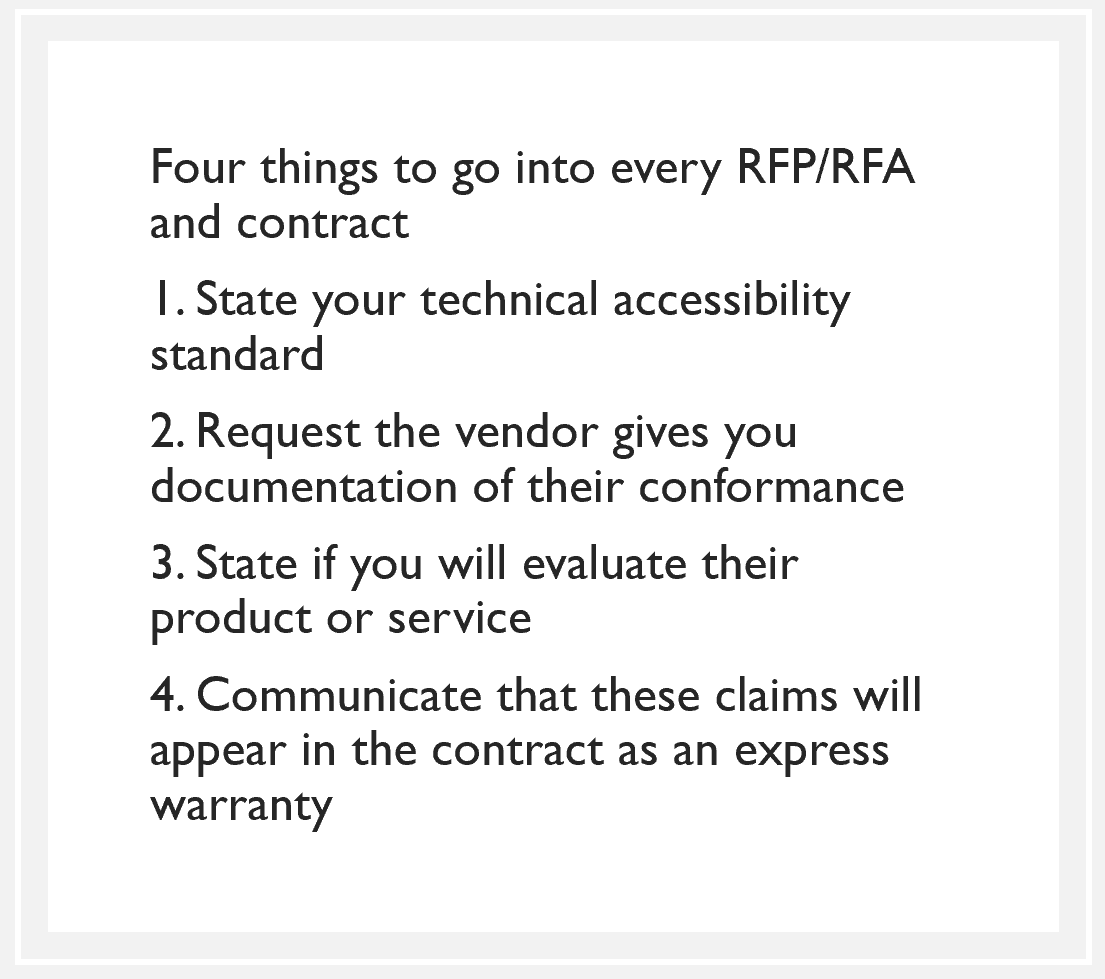
- State that the product or service must conform to your institutional accessibility standard; for most of you this will be the Web Content Accessibility Guidelines (WCAG) 2 Level AA.
- Request that the vendor provide you with information on the conformance of their product to this standard; or in the case of a contractor, guarantees that performance will include conformance. While vendor information can take several forms, many institutions have elected to use the very same Voluntary Product Accessibility Template (VPAT currently v 2.2) as is used in Federal procurements. This is simply because many vendors have them already and understand this process. It is critical to understand that VPAT’s are most often created BY the vendors themselves. Know that they are incentivized to communicate to you that everything is fine with accessibility. With that said, a thorough and accurate VPAT can be very informative. Maybe more importantly, it provides an accessibility claim that should be referenced in the contract. Here is an example of a VPAT for the LMS, Canvas.
- State if you intend to evaluate the materials they submit. Few purchasing offices are staffed with individuals that have the technical knowledge to review VPATs or other documentation according to the technical standards. Also, occasionally VPATs are filled out in ways that are too vague to provide a clear picture of conformance (although this should be a red flag when evaluating vendors). As such, you would need processes in place to engage in your own due diligence, and spot check what they provide to you. An accessible procurement team can be identified by the institution to help evaluate what was submitted; often they come from the institutional accessibility team.Be mindful of what the vendor represents to you, and make sure you spot check their entire product. For example, it does you no good if an LMS vendor talks about the accessibility of the student interface but does not mention the inaccessibility of the instructor interface. Or that their core product is accessible, but they fail to mention that none of the extensions you plan to purchase from them and use with their core product are accessible. If you do not like a VPAT process that feels like the fox guarding the hen house, feel free to require an independent third-party evaluation in your announcement.This is more common that you might think. For example, the California State University (CSU) System requires that vendors of larger procurements must offer an independent third-party evaluation report. This is in line with their belief that the institution should not have to bear the cost of evaluating vendor products; which is what happens when an internal team performs an evaluation; it becomes an institutional cost through time and effort of personnel. The CSU also includes a requirement that finalists demonstrate their product and include accessibility in that demonstration (e.g. a CSU staff or student with a disability might use their assistive technology to run the program during part of the demonstration). The demonstration is requested as a way to validate the claims of the vendor and engage in due diligence prior to procurement. No matter your process for evaluation, it should be fully detailed in the RFP/RFA so you are attracting those serious about accessibility. An example of this can be found at the CSU Vendor Accessibility Requirements.
- Announce that the vendor’s accessibility claims will be presented in the contract as an express warranty for the current product as well as any updates. This gives you room to require that accessibility deficits that are found later are changed immediately. Moreover, it will set forth the expectation that future updates include conformance to existing accessibility standards. A common topic of accessibility conversation on campuses across the nation is how a recent update broke accessibility features, or how a new feature development did not include it whatsoever.While having an accessibility warranty in your contract could also set forth a breach of contract by the vendor, nobody really wants it to get to that stage. Yet, pulling back your costs could offset a negative fiscal impact amid a legal complaint or if the vendor refuses to allow changes. You may also want to notify the vendor that you will require them to provide you with an accessibility development roadmap to be added to the contract for any feature where accessibility is not in current conformance (e.g., where items are not “supported” on the VPAT if you use such a thing). This could then bind them contractually to stick with the roadmap and timelines, depending on other contractual items. Having this in your contract language may also demonstrate institutional good faith should a complaint arise. But remember that having a promise of accessibility is not the same as having a product that is accessible. Until you reach that time, your institution will have to bear the cost of accommodations, along with a few sleepless nights as you worry about broader legal liability.
Here are examples of language, or information given to vendors for accessible procurements:
Step 4: Create systems to support accessible procurements from faculty and staff
What if a free or low-dollar procurement is made by faculty or staff? No matter who initiated the procurement, the enterprise is responsible for accessibility if an employee or patron with a disability requires it. Some campuses now have processes in place where faculty and staff engage in sharing information that will help the institution determine risk and ultimate cost. One example of this can be found at the University of California at Irvine (scroll down to the checklist form). They ask faculty and staff to fill out a checklist so that accessibility and security concerns can be reviewed centrally. Depending on the result, a technical review by central staff may be required.
You will not catch everything, but having a system in place certainly helps. While some accommodations will occur, keep your eye on preventing this need. Courts have ruled that institutions have an affirmative obligation to work in advance of the need for auxiliary aids and services; in other words, you should have known someone with a disability would need to access this at some point and you should have something that works for them. Having policies and procedures in place such as these shows a good faith effort on the part of the institution.
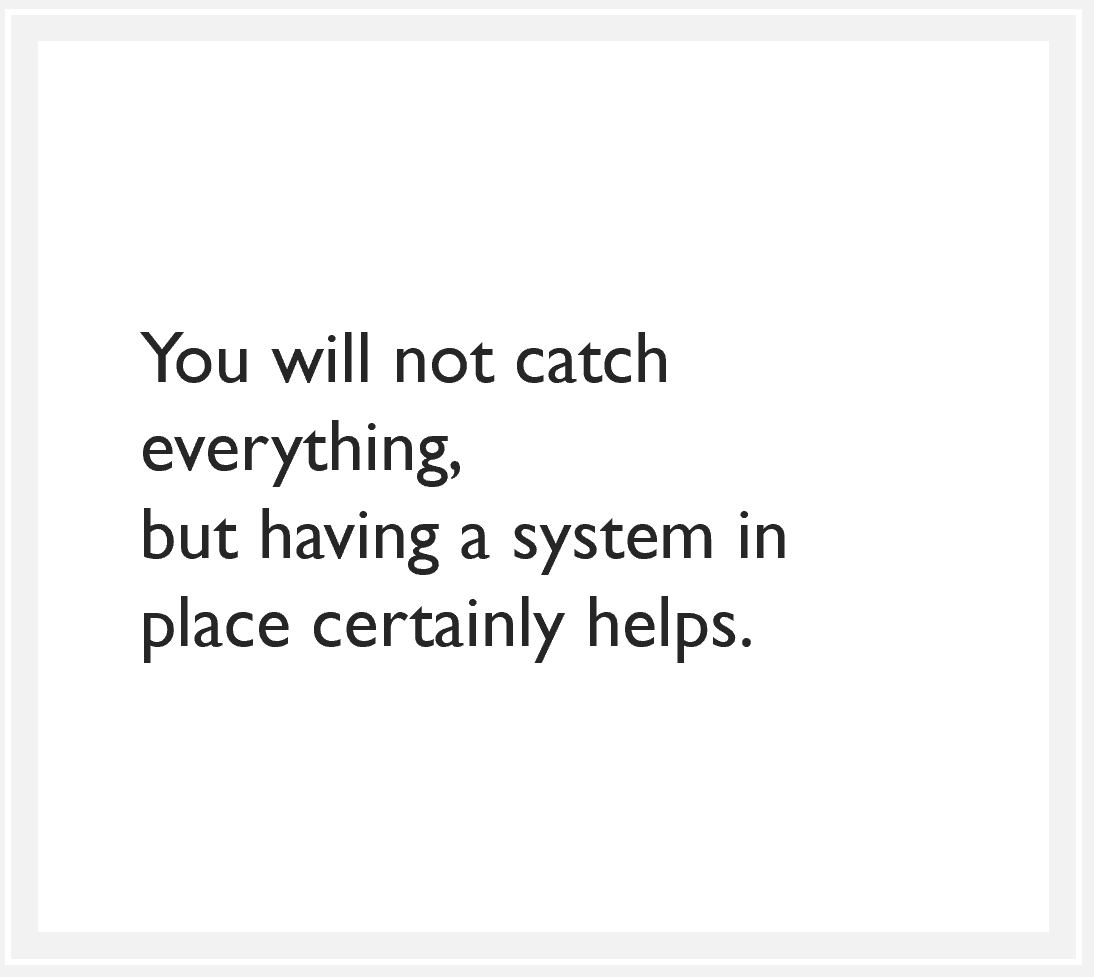
Step 5: Find resources to help
There are several resources that may help you establish a solid procurement policy and process. The best is really to look at what others are already doing so that you don’t have to completely reinvent the wheel. The good news is that there are some good resources available to help if you are new to this. I would encourage readers to review the PEAT article “Accessible Technology: It starts with Procurement” and NCDAE’s article “Let the Buyer be Aware: The importance of procurement in accessibility policy”.
I would also encourage you to focus on creating systems that are supportive and friendly to faculty and staff. We all want to succeed in what we are doing. You can see how the process identified by the University of Nevada at Reno helps everyone understand the process and why it is in place. This transparency helps all involved. Here are additional examples of step-by-step guides. One example is the 9-step process identified by the University of California at Channel Islands. Also, a 3 step process from the University of Washington. Finally, here is NC State’s process of above and below a $5,000 purchasing threshold.
I want to provide you with one more set of resources before I end. There is much discussion in the higher education accessibility community about how each procurement office is duplicating the efforts of others as each evaluates products on their own; to a certain extent we may all be reinventing the wheel. Here are some groups that are trying to share their information with others:
Be aware, however, that in many instances what you will find is limited information. For example, the versions of products may be unknown. You may not know much at all about what was evaluated (scope), how it was evaluated (methods), or the skills of the person who did the evaluation (expertise). Moreover, we don’t have any data on test-retest or inter-rater reliability of these evaluators or evaluations. So, are repositories like this helpful? You would not want pin all your institutional risk on these summaries, but the content of these repositories are wonderful places to start collecting information you can use in a broader process to verify products on your own. Perhaps instead of reinventing the wheel, you only duplicate the effort of two spokes?
One very promising framework for sharing information comes from the Department of Homeland Security. It is called Trusted Tester. It is a free course (available to anyone), that culminates in a performance-based certification exam. It was recently updated to reflect the refreshed Section 508 standards. If the learner passes the performance-based course exam, it verifies that they have the demonstrated skill to perform a systematic accessibility evaluation.
When evaluation results are based on a common methodology by persons with common confirmed expertise, the results can be “trusted”. Many groups have looked at the unique needs of the higher education community and wondered if Trusted Tester collaboratives might be part of a solution (e.g., the collaboratives could share information obtained from a common metric by certified individuals, thus reducing individual evaluations of all products). As this idea works its way through decision-making bodies, knowing that some are sharing the little information they have can still be useful.
Stop Digging. Create an Accessibility Procurement Process

Creating and using a procurement process that includes a focus on accessibility will help your institution stop digging a deeper accessibility hole. Over time, with training, and updates to your digital infrastructure, you will be above ground.
I look forward to discussions on this blog post below. If you would like to discuss issues of accessibility with me directly, don’t hesitate to contact me Cyndi.Rowland@usu.edu.

Cyndi Rowland
Executive Director, WebAIM, and
Technology Director
National Center on Disability and Access to Education
All housed at Utah State University










3 replies on “The Role of Procurement in Digital Accessibility”
[…] we are going to bring to campus and use in our courses. Cyndi Rowland wrote a great piece about “The Role of Procurement in Digital Accessibility” right before the WCET annual meeting. Since we are gathering together in Orlando this week for […]
[…] we are going to bring to campus and use in our courses. Cyndi Rowland wrote a great piece about “The Role of Procurement in Digital Accessibility” right before the WCET annual meeting. Since we are about to gather together in Orlando for […]
[…] Cyndi Rowland and I have shared in our previous blogs on the topic procurement and accessibility (The Role of Procurement in Digital Accessibility and Accessibility & Procurement: What do we nee…), we recommend that institutions build accessibility into the regular procurement processes in […]